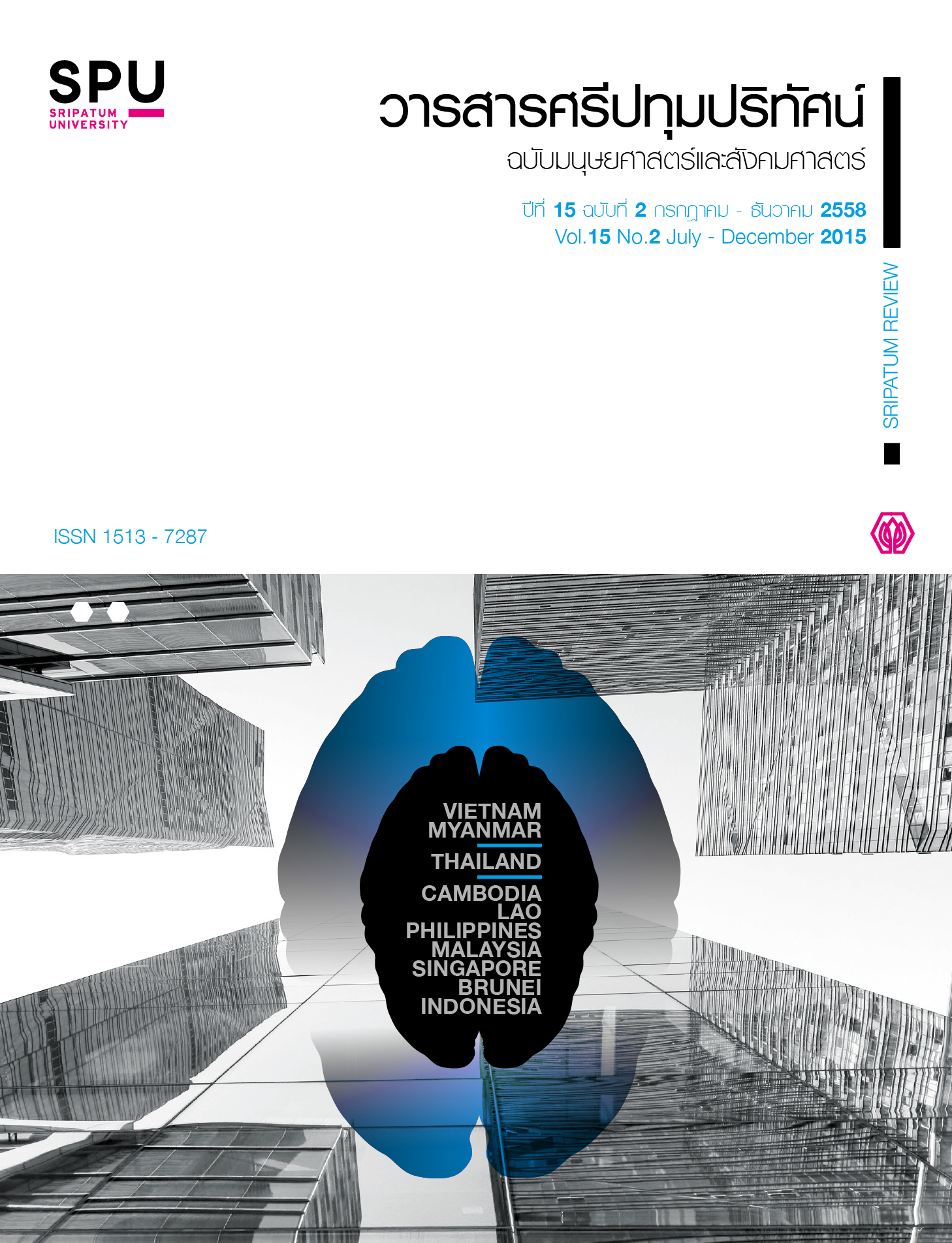DEVELOPMENT OF A RISK MANAGEMENT PROCESS IN INSTRUCTIONAL MANAGEMENT OF THE DEPARTMENTS IN PRIVATE UNIVERSITIES: AN APPLICATION OF INTERNATIONAL RISK MANAGEMENT STANDARD: ISO 31000
Main Article Content
Abstract
The objectives of this research were (1) to develop a risk management process in instructional management for the departments in private universities with application of the international risk management standard: ISO 31000; and (2) to assess the efficiency of the developed risk management process. This study was a research and development study comprising four phases, namely, phase 1: a study of concepts and approaches concerning the operation of risk management process, phase 2: the development of risk management process, phase 3: the try-out and evaluation of the risk management process, and phase 4: the improvement of the risk management process. Research data were collected via documentary study, interviews, the use of questionnaires, and focus group discussion. Quantitative data were analyzed with the use of descriptive statistics; while qualitative data were analyzed with content analysis. Research findings were as follows:
1. The risk management process in instructional management of the departments in private universities was composed of two components: 1.1 the component of preparation for risk management, which comprised (1) the readiness preparation consisting of (1.1) formulation of risk management policy; (1.2) determination of risk management process; (1.3) appointment of the committee for risk management with specification of its duty, roles and responsibility; (1.4) development of the manual for implementation of risk management process; and (1.5) identification of instructors or practitioners; and (2) the imparting of knowledge and understanding concerning the operation of risk management process; and 1.2 the component of implementing the risk management process, which comprised (1) the determination of objectives and conditions of internal and external environment; (2) the identification of risks; (3) the analysis of risks; (4) the evaluation of risks; (5) the management of risks; (6) the instilling of understanding and the implementation of risk management plan; (7) the follow-up; and (8) the review.
2. Regarding the try-out results of the developed risk management process, it was found that the developed risk management process was efficient in accordance with the four standards of evaluation, namely, (1) the propriety standard: the developed risk management process was in accord with the guidelines for risk management operation determined by the Commission on Higher Education; (2) the feasibility standard: the implementation process was acceptable for practitioners with clear operational steps that could be implemented in real situations; (3) the utility standard: the departments could prepare their readiness to accommodate the changes that could occur in instructional management, increase knowledge and understanding of stakeholders concerning the risk management process, and enable them to operate the risk management process on a continuous basis; and (4) the accuracy standard: the data and information about the risk management process were accurate and reliable resulting in the conclusion report on the operation of risk management process being accurate and reliable for subsequent submission to administrators at the faculty and institution.
Article Details
1. กองบรรณาธิการสงวนสิทธิ์ในการพิจารณาและตัดสินการตีพิมพ์บทความในวารสาร
2. บทความทุกเรื่องจะได้รับการตรวจสอบทางวิชาการโดยผู้ทรงคุณวุฒิ แต่ข้อความและเนื้อหาในบทความที่ตีพิมพ์เป็นความรับผิดชอบของผู้เขียนแต่เพียงผู้เดียว มิใช่ความคิดเห็นและความรับผิดชอบของมหาวิทยาลัยศรีปทุม
3. การคัดลอกอ้างอิงต้องดำเนินการตามการปฏิบัติในหมู่นักวิชาการโดยทั่วไป และสอดคล้องกับกฎหมายที่เกี่ยวข้อง
References
ขนิษฐา ชัยรัตนาวรรณ. 2011. การบริหารความเสี่ยงสากล ISO 31000 กับระบบการศึกษาของไทย. วารสารวิชาการ Veridian E-Journal 4( 1): 419-434.
ขนิษฐา ชัยรัตนาวรรณ.2557. ความเสี่ยง: ปัจจัยสำคัญ ผู้ที่เกี่ยวข้อง และกระบวนการบริหารความเสี่ยงในสถาบันอุดมศึกษาไทย. วารสารวิชาการ Veridian E-Journal 7( 2): 106-120.
จิรพร สุเมธีประสิทธิ์. 2555. มารู้จักมาตรฐานการบริหารความเสี่ยงระดับสากลกัน. สืบค้นเมื่อวันที่ 31 พฤษภาคม 2556 .
ณรงค์ อยู่ถนอม. 2554. รายงานผลการฝึกอบรม โครงการอบรมเชิงปฏิบัติการ หลักสูตร “การบริหารงานอุดมศึกษาระดับสูง” รุ่นที่ 4. กรุงเทพมหานคร: มหาวิทยาลัยศรีปทุม.
ธรรญา สุขสมัย. 2552. เอกสารประกอบการอบรมเชิงปฏิบัติการ เรื่อง การบริหารความเสี่ยงขององค์กรแบบบูรณาการ. วันที่ 12-13 มิถุนายน 2552, สถาบันวิจัยและพัฒนาเพื่ออุตสาหกรรม สภาอุตสาหกรรมแห่งประเทศไทย.
นริศ โรจน์วิศาลทรัพย์. 2550. การประเมินความเสี่ยงและความปลอดภัยในโรงงาน. สำนักพัฒนาศักยภาพนักวิทยาศาสตร์ห้องปฏิบัติการ, ย่งอินเตอร์เทรด.
ประภาพรรณ รักเลี้ยง และคณะ. 2556. “การพัฒนารูปแบบการบริหารความเสี่ยงของสถาบันอุดมศึกษาเอกชน.” วารสารศึกษาศาสตร์ มหาวิทยาลัยนเรศวร 15(3): 59-65.
ประเสริฐ อัครประถมพงศ์. 17 มีนาคม 2555. ผู้ช่วยอธิการบดี จุฬาลงกรณ์มหาวิทยาลัย. สัมภาษณ์.
วิทยากร เชียงกูล. 2555. การศึกษาไทยใช้งบสูง แต่ประสิทธิภาพ/คุณภาพต่ำ. สืบค้นเมื่อวันที่ 27 ธันวาคม 2555.
วุฒิชัย ธนาพงศธร, เอกธิป สุขวารี และ กัลญา โอภาสเสถียร. 2552. การวิจัยเรื่อง การพัฒนาตัวบ่งชี้เพื่อกำกับติดตามการจัดการอุดมศึกษาตามกรอบมาตรฐานการอุดมศึกษาและกรอบแผนอุดมศึกษาระยะยาว 15 ปี ฉบับที่ 2 (พ.ศ. 2551-2565). กรุงเทพมหานคร: สำนักงานคณะกรรมการการอุดมศึกษา.
ศิริชัย กาญจนวาสี. 2547. ทฤษฎีการประเมิน. พิมพ์ครั้งที่ 4. กรุงเทพมหานคร : จุฬาลงกรณ์มหาวิทยาลัย.
ศูนย์สำรวจความคิดเห็น “นิด้าโพล”. 2557. ปัญหาคุณภาพบัณฑิตไทย. สืบค้นเมื่อวันที่ 17 กันยายน พ.ศ. 2557.
สำนักงานเลขาธิการสภาการศึกษา. 2552. รายงานการสังเคราะห์งานวิจัยเกี่ยวกับคุณภาพการศึกษาไทย : การวิเคราะห์ อภิมาน (meta-analysis) . กรุงเทพมหานคร : สำนักประเมินผลการจัดการศึกษา.
สำนักงานคณะกรรมการการอุดมศึกษา. สำนักมาตรฐานและประเมินผลอุดมศึกษา. 2554. คู่มือการประกันคุณภาพการศึกษาภายในสถานศึกษา ระดับอุดมศึกษา พ.ศ. 2553. พิมพ์ครั้งที่ 3. กรุงเทพมหานคร : ภาพพิมพ์.
สำนักงานคณะกรรมการการอุดมศึกษา.2558. คู่มือการประกันคุณภาพการศึกษาภายใน ระดับอุดมศึกษา พ.ศ. 2557. กรุงเทพมหานคร : ภาพพิมพ์.
สุพรรณิการ์ ธรรมนิทัศนา. 2550. “การประยุกต์ ใช้มาตรฐานการบริหารความเสี่ยงสำหรับองค์กรอุตสาหกรรมการผลิต กรณีศึกษา อุตสาหกรรมแปรรูปกระดาษ.” วิทยานิพนธ์ปริญญามหาบัณฑิต สาขาวิชาวิศวกรรมอุตสาหการ บัณฑิตวิทยาลัย จุฬาลงกรณ์มหาวิทยาลัย.
สมหวัง พิธิยานุวัฒน์. 2549. วิธีวิทยาการประเมินศาสตร์แห่งคุณค่า. พิมพ์ครั้งที่ 3. กรุงเทพมหานคร: จุฬาลงกรณ์มหาวิทยาลัย.
Carl A. Gibson. 2009. Seminar & workshop on developing an integrated approach to risk management in University. สมาคมศูนย์วิชาการไทย-ออสเตรเลีย, 14-16 พฤศจิกายน 2552. กรุงเทพมหานคร : โรงแรม วินเซอร์ สวีทส์.
International Organization for Standard ISO. 2009. Risk Management-Principles and Guidelines. Retrived September 29, 2010.
Knight, Kevin. W. 2009. ISO 31000 Provides Risk Management Framework. Standards & Regulations News.
Siri Thongsiri & Winai Plueksawan. 2009. Practical risk management an application of ISO 31000 standard and risk assessment techniques IEC 31010. Thai-Australian Technological Services Center, Training Manual, Bangkok. 7-9 November 2009.


